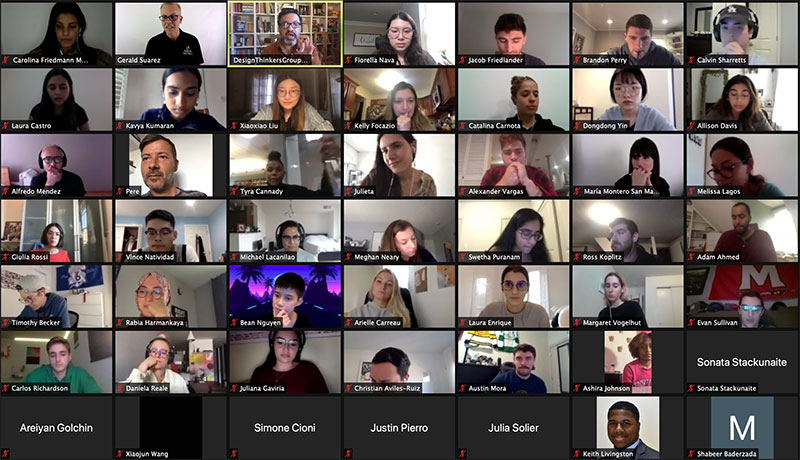
Travel had ground to a halt and learning was mostly online in 2020’s fall semester, but at Maryland Smith, global educational experiences were forging ahead in new ways.
Smith’s J. Gerald Suarez led students from BMGT468Z: Creating the Future through Systems Thinking and Design, as well as students from Elisava and LaInnovationKitchen in Barcelona, in an application of systems and design thinking to reimagine the healthcare experience amid the COVID-19 pandemic. The students collaborated with their international peers to apply classroom concepts and frameworks toward redesigning the healthcare experience for Bethesda-based Adventist HealthCare Inc.
The pandemic, Suarez says, while disruptive, also provided an opportunity to create an immersive, reality-centric and highly engaging learning experience for students.
“I’ve always believed in never letting what has happened interfere with what could be,” says Suarez, professor of the practice in systems thinking and design at the University of Maryland's Robert H. Smith School of Business. “The question: ‘What can I do virtually during the pandemic that would not be otherwise possible in person?’ served as the catalyst to explore audacious instructional possibilities.”
During the course of the project, Suarez says, students had to integrate new team members into their teams, overcome communication barriers, create agreeable norms, embrace different healthcare paradigms and deal with the logistical complexity imposed by the six-hour time difference.
Students virtually visited the Adventist HealthCare facility by conducting interviews with staff and administrators to address issues impacting families, patients and providers. At the end of the project, teams presented their findings and ideas to Jonathan Sachs, vice president of patient experience at Adventist.
Student Allison Davis said being exposed to the rigor and challenges of working in global teams was a welcome opportunity.
“Professor Suarez encouraged us to meet the moment, showcase our talents and abilities and take advantage of this phenomenal opportunity to work alongside students from differing backgrounds, locations and perspectives across the globe,” Davis said in a blog post. “He stressed that we are the ambassadors of UMD to our global partners and in the territory of pioneers, paving the way for future online global experiences. I was so excited to build relationships with my international team members and learn from them about the design-thinking process.”
The global classroom component of this course was funded by the Title VI CIBE grant awarded to Maryland Smith’s Center for Global Business and administered by the U.S. Department of Education.
The course, Suarez says, removed the confines of the classroom and helped change the students’ mindset from obstructions to possibilities.
It’s immersive learning experiences like these, he says, that help convey the potential of online learning and provide valuable lessons for students.
“Students gained a sense of empowerment and direction at a time when they may feel overwhelmed by the magnitude of current affairs or the crisis of the moment,” he says. “Being involved in reality-centric projects shrinks the gap between the classroom and real life, which makes these lessons enduring.”
Media Contact
Greg Muraski
Media Relations Manager
301-405-5283
301-892-0973 Mobile
gmuraski@umd.edu
About the University of Maryland's Robert H. Smith School of Business
The Robert H. Smith School of Business is an internationally recognized leader in management education and research. One of 12 colleges and schools at the University of Maryland, College Park, the Smith School offers undergraduate, full-time and flex MBA, executive MBA, online MBA, business master’s, PhD and executive education programs, as well as outreach services to the corporate community. The school offers its degree, custom and certification programs in learning locations in North America and Asia.